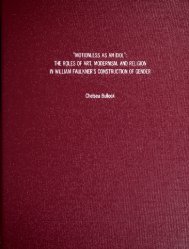The Effect of Aposematic Coloration on the Food Preference of ...
The Effect of Aposematic Coloration on the Food Preference of ...
The Effect of Aposematic Coloration on the Food Preference of ...
- No tags were found...
Create successful ePaper yourself
Turn your PDF publications into a flip-book with our unique Google optimized e-Paper software.
necessary to mimic <strong>the</strong> jcquirity beans.<str<strong>on</strong>g>The</str<strong>on</strong>g> next attempt involved dipping <strong>the</strong> beans in dyedparaffin.<str<strong>on</strong>g>The</str<strong>on</strong>g> paraffin was melted in a metal pot over a stove burner and red-orange tempurapaint was added to give it color. Straight pins were stuck into <strong>the</strong> ends <str<strong>on</strong>g>of</str<strong>on</strong>g> <strong>the</strong> beans and <strong>the</strong>ywere hand-dipped, like candles, into <strong>the</strong> wax.When <strong>the</strong>y were removed from <strong>the</strong> wax, <strong>the</strong>y weresmoothly coated but with no color.Because paraffin is n<strong>on</strong>-polar and tempura paint is waterbased, <strong>the</strong> two would not mix. Thus, I had to find a dye that would mix with <strong>the</strong> paraffin. <str<strong>on</strong>g>The</str<strong>on</strong>g>problem with this was that most oil-based paints are toxic because <strong>the</strong>y c<strong>on</strong>tain heavy metals.<str<strong>on</strong>g>The</str<strong>on</strong>g> soluti<strong>on</strong> to this problem came unexpectedly when my fa<strong>the</strong>r made a comment about how I,as a child, chewed <strong>on</strong> cray<strong>on</strong>s. I <strong>the</strong>n ga<strong>the</strong>red several red-orange Crayola cray<strong>on</strong>s and melted<strong>the</strong>m in a metal pot as d<strong>on</strong>e previously with <strong>the</strong> paraffin.Beans were dipped as before usingstraight pins. I found that if <strong>the</strong> melted cray<strong>on</strong> were too hot, <strong>the</strong> cray<strong>on</strong> would slide <str<strong>on</strong>g>of</str<strong>on</strong>g>f <str<strong>on</strong>g>of</str<strong>on</strong>g> <strong>the</strong>beans before hardening.To solve this problem, <strong>the</strong> cray<strong>on</strong> wax was brought to a boil andallowed to cool for approximately 30 sec<strong>on</strong>ds before dipping <strong>the</strong> beans.<str<strong>on</strong>g>The</str<strong>on</strong>g> beans were placed<strong>on</strong> wax paper to dry and were left for about an hour.After drying, <strong>the</strong> black ends were paintedusing n<strong>on</strong>-toxic water base finger paint.<str<strong>on</strong>g>The</str<strong>on</strong>g> c<strong>on</strong>trols were prepared by dipping beans, using <strong>the</strong>method described above, in clear paraffin.This gave both types <str<strong>on</strong>g>of</str<strong>on</strong>g> beans a syn<strong>the</strong>tic waxy coat.After <strong>the</strong> model beans were finished, I again traveled to Florida, this time to c<strong>on</strong>duct <strong>the</strong>first set <str<strong>on</strong>g>of</str<strong>on</strong>g> trials.This porti<strong>on</strong> <str<strong>on</strong>g>of</str<strong>on</strong>g> <strong>the</strong> study was c<strong>on</strong>ducted from May 19 to May 24, 2002, during<strong>the</strong> early nesting period <str<strong>on</strong>g>of</str<strong>on</strong>g> <strong>the</strong> scrub jays.I chose to hand feed <strong>the</strong> birds after observing thatsome have an unusual affinity for human c<strong>on</strong>tact.<str<strong>on</strong>g>The</str<strong>on</strong>g>re were four sites identified by locati<strong>on</strong>near landmarks, including parks and roads.<str<strong>on</strong>g>The</str<strong>on</strong>g> first site was located near a walking trail atCarlin Park in Palm Beach County.At this site, <strong>on</strong>e breeding pair <str<strong>on</strong>g>of</str<strong>on</strong>g> scrub jays was located.This was expected, as breeding jays tend to be very territorial when nesting.Territorial behavior
















